HI5017 Managerial Accounting Report: Costing Methods Comparison
VerifiedAdded on 2022/08/21
|11
|3679
|105
Report
AI Summary
This report provides a comprehensive comparison of standard costing and target costing methods within the context of managerial accounting. It begins with an executive summary, followed by an introduction that outlines the report's objectives. The report then delves into the characteristics of standard costing, defining it as a pre-determined cost estimate used for production, and explores its advantages, such as supporting budgeting and cost control, as well as its disadvantages, including potential inflexibility. A literature review of standard costing, drawing on Paul Eisenberg's work, is included. The report then discusses target costing, highlighting its role in cost reduction and revenue enhancement, and outlines the steps for its implementation. The core of the report is a comparison between standard and target costing, emphasizing their differences in approach and application, particularly in relation to market dynamics and cost control. The report concludes by summarizing the key findings and implications for companies operating in a competitive business environment. The report is based on an assignment submitted by a student for the HI5017 Managerial Accounting course at Holmes Institute.
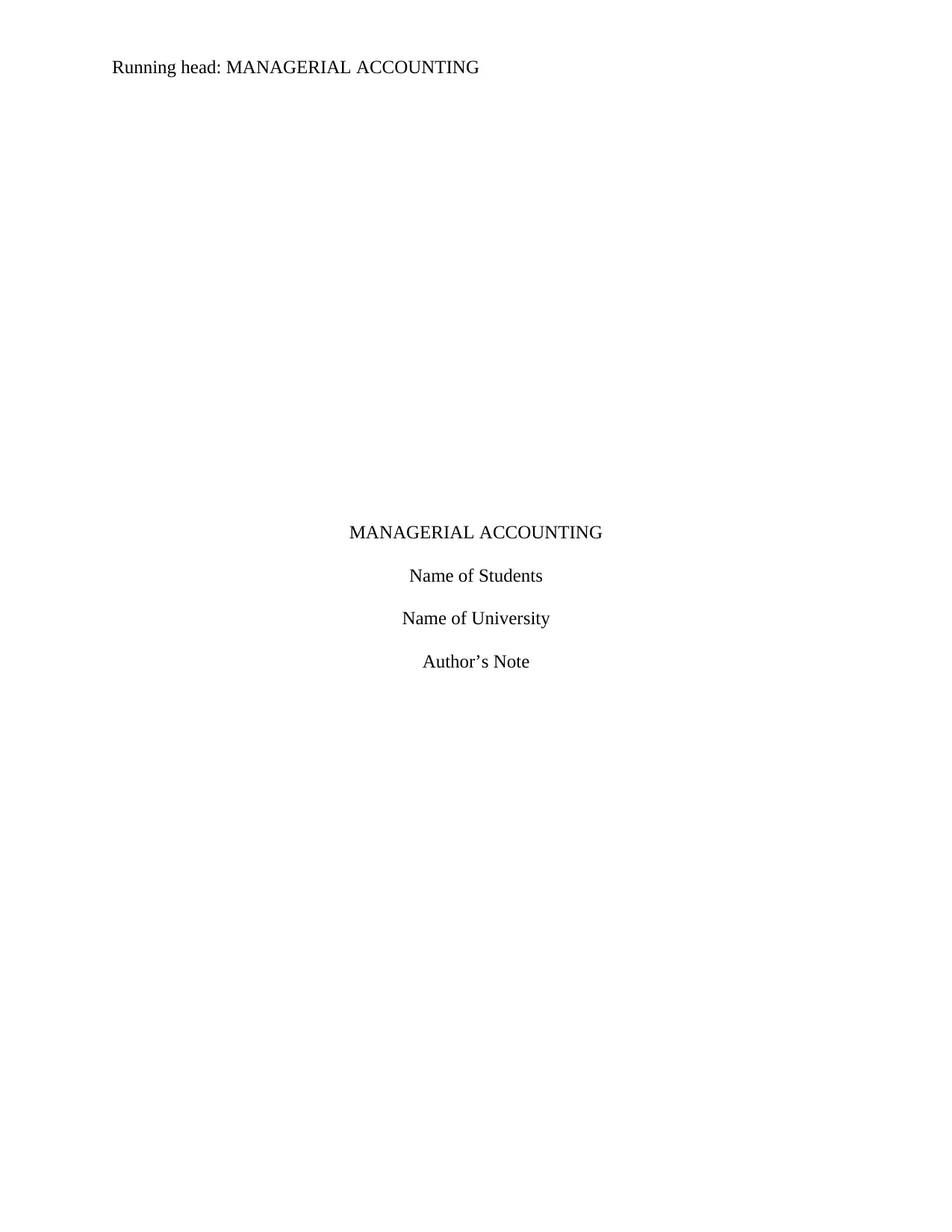
Running head: MANAGERIAL ACCOUNTING
MANAGERIAL ACCOUNTING
Name of Students
Name of University
Author’s Note
MANAGERIAL ACCOUNTING
Name of Students
Name of University
Author’s Note
Paraphrase This Document
Need a fresh take? Get an instant paraphrase of this document with our AI Paraphraser
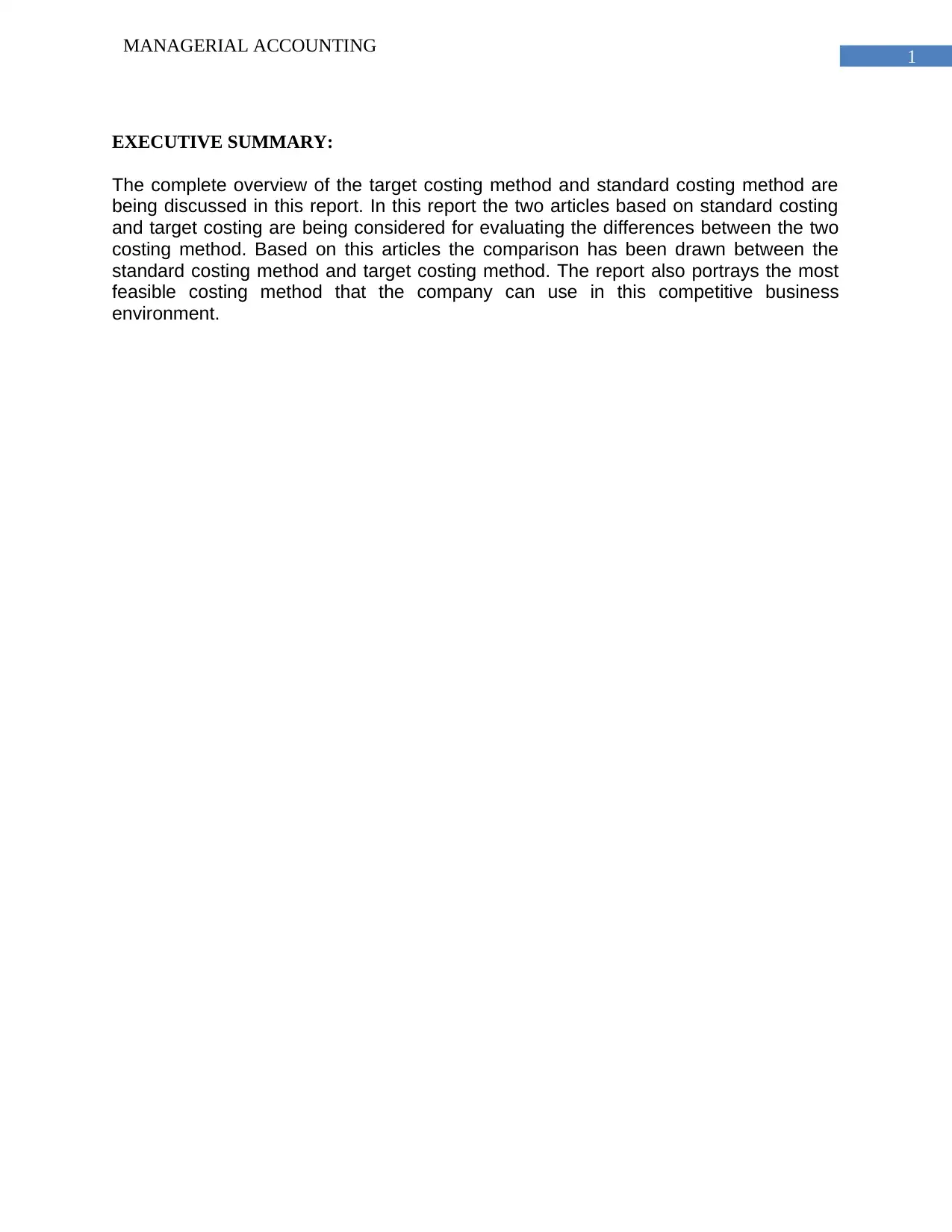
1
MANAGERIAL ACCOUNTING
EXECUTIVE SUMMARY:
The complete overview of the target costing method and standard costing method are
being discussed in this report. In this report the two articles based on standard costing
and target costing are being considered for evaluating the differences between the two
costing method. Based on this articles the comparison has been drawn between the
standard costing method and target costing method. The report also portrays the most
feasible costing method that the company can use in this competitive business
environment.
MANAGERIAL ACCOUNTING
EXECUTIVE SUMMARY:
The complete overview of the target costing method and standard costing method are
being discussed in this report. In this report the two articles based on standard costing
and target costing are being considered for evaluating the differences between the two
costing method. Based on this articles the comparison has been drawn between the
standard costing method and target costing method. The report also portrays the most
feasible costing method that the company can use in this competitive business
environment.
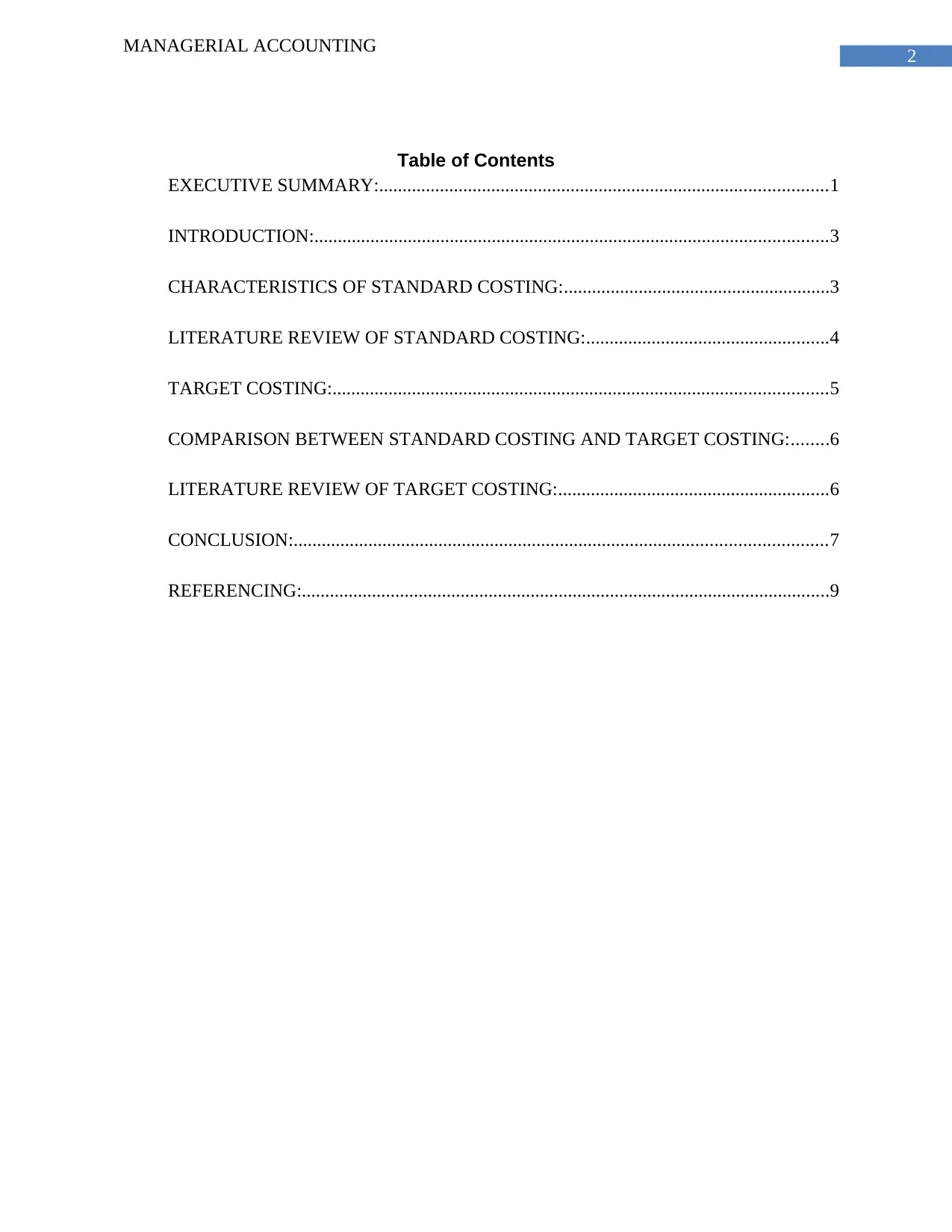
2
MANAGERIAL ACCOUNTING
Table of Contents
EXECUTIVE SUMMARY:................................................................................................1
INTRODUCTION:..............................................................................................................3
CHARACTERISTICS OF STANDARD COSTING:.........................................................3
LITERATURE REVIEW OF STANDARD COSTING:....................................................4
TARGET COSTING:..........................................................................................................5
COMPARISON BETWEEN STANDARD COSTING AND TARGET COSTING:........6
LITERATURE REVIEW OF TARGET COSTING:..........................................................6
CONCLUSION:..................................................................................................................7
REFERENCING:.................................................................................................................9
MANAGERIAL ACCOUNTING
Table of Contents
EXECUTIVE SUMMARY:................................................................................................1
INTRODUCTION:..............................................................................................................3
CHARACTERISTICS OF STANDARD COSTING:.........................................................3
LITERATURE REVIEW OF STANDARD COSTING:....................................................4
TARGET COSTING:..........................................................................................................5
COMPARISON BETWEEN STANDARD COSTING AND TARGET COSTING:........6
LITERATURE REVIEW OF TARGET COSTING:..........................................................6
CONCLUSION:..................................................................................................................7
REFERENCING:.................................................................................................................9
⊘ This is a preview!⊘
Do you want full access?
Subscribe today to unlock all pages.

Trusted by 1+ million students worldwide
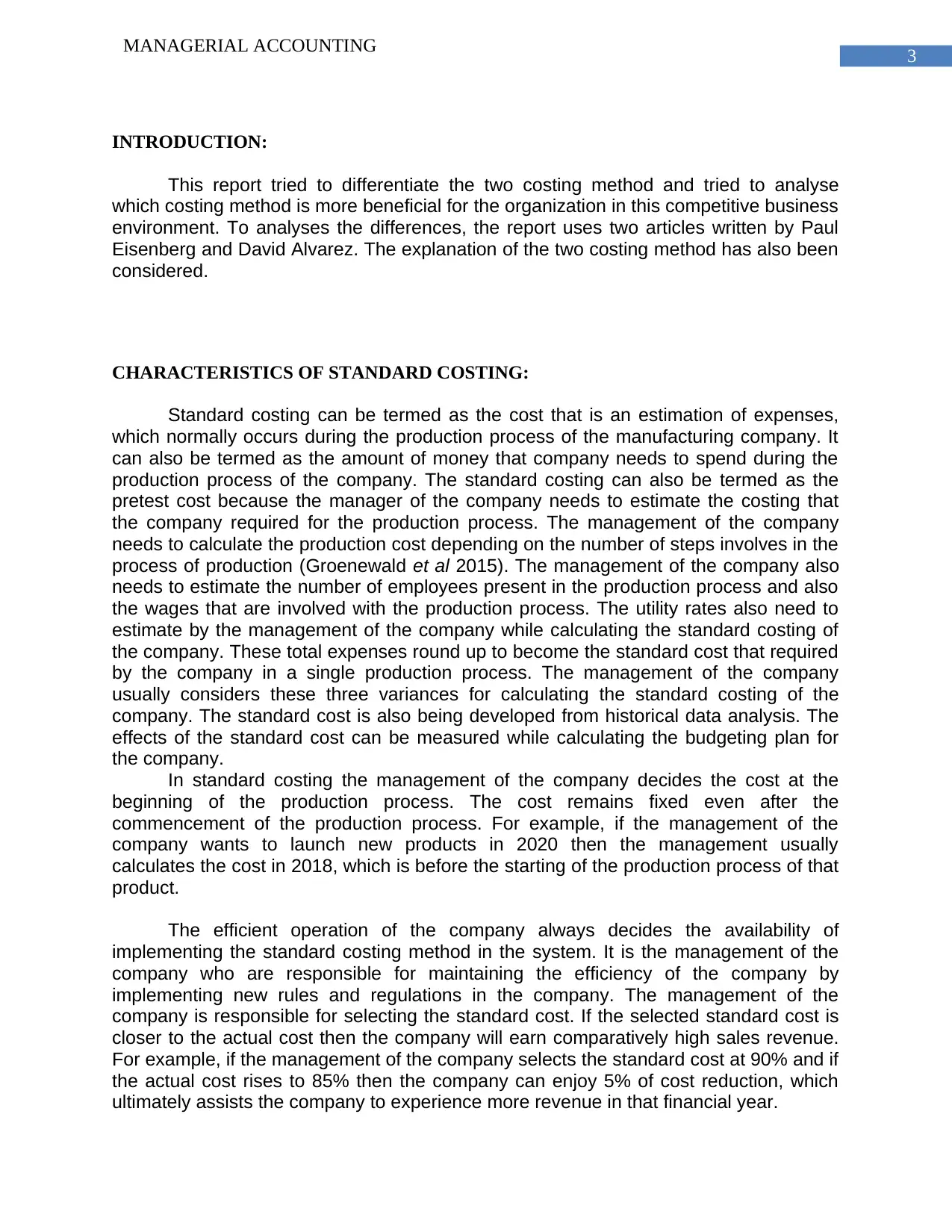
3
MANAGERIAL ACCOUNTING
INTRODUCTION:
This report tried to differentiate the two costing method and tried to analyse
which costing method is more beneficial for the organization in this competitive business
environment. To analyses the differences, the report uses two articles written by Paul
Eisenberg and David Alvarez. The explanation of the two costing method has also been
considered.
CHARACTERISTICS OF STANDARD COSTING:
Standard costing can be termed as the cost that is an estimation of expenses,
which normally occurs during the production process of the manufacturing company. It
can also be termed as the amount of money that company needs to spend during the
production process of the company. The standard costing can also be termed as the
pretest cost because the manager of the company needs to estimate the costing that
the company required for the production process. The management of the company
needs to calculate the production cost depending on the number of steps involves in the
process of production (Groenewald et al 2015). The management of the company also
needs to estimate the number of employees present in the production process and also
the wages that are involved with the production process. The utility rates also need to
estimate by the management of the company while calculating the standard costing of
the company. These total expenses round up to become the standard cost that required
by the company in a single production process. The management of the company
usually considers these three variances for calculating the standard costing of the
company. The standard cost is also being developed from historical data analysis. The
effects of the standard cost can be measured while calculating the budgeting plan for
the company.
In standard costing the management of the company decides the cost at the
beginning of the production process. The cost remains fixed even after the
commencement of the production process. For example, if the management of the
company wants to launch new products in 2020 then the management usually
calculates the cost in 2018, which is before the starting of the production process of that
product.
The efficient operation of the company always decides the availability of
implementing the standard costing method in the system. It is the management of the
company who are responsible for maintaining the efficiency of the company by
implementing new rules and regulations in the company. The management of the
company is responsible for selecting the standard cost. If the selected standard cost is
closer to the actual cost then the company will earn comparatively high sales revenue.
For example, if the management of the company selects the standard cost at 90% and if
the actual cost rises to 85% then the company can enjoy 5% of cost reduction, which
ultimately assists the company to experience more revenue in that financial year.
MANAGERIAL ACCOUNTING
INTRODUCTION:
This report tried to differentiate the two costing method and tried to analyse
which costing method is more beneficial for the organization in this competitive business
environment. To analyses the differences, the report uses two articles written by Paul
Eisenberg and David Alvarez. The explanation of the two costing method has also been
considered.
CHARACTERISTICS OF STANDARD COSTING:
Standard costing can be termed as the cost that is an estimation of expenses,
which normally occurs during the production process of the manufacturing company. It
can also be termed as the amount of money that company needs to spend during the
production process of the company. The standard costing can also be termed as the
pretest cost because the manager of the company needs to estimate the costing that
the company required for the production process. The management of the company
needs to calculate the production cost depending on the number of steps involves in the
process of production (Groenewald et al 2015). The management of the company also
needs to estimate the number of employees present in the production process and also
the wages that are involved with the production process. The utility rates also need to
estimate by the management of the company while calculating the standard costing of
the company. These total expenses round up to become the standard cost that required
by the company in a single production process. The management of the company
usually considers these three variances for calculating the standard costing of the
company. The standard cost is also being developed from historical data analysis. The
effects of the standard cost can be measured while calculating the budgeting plan for
the company.
In standard costing the management of the company decides the cost at the
beginning of the production process. The cost remains fixed even after the
commencement of the production process. For example, if the management of the
company wants to launch new products in 2020 then the management usually
calculates the cost in 2018, which is before the starting of the production process of that
product.
The efficient operation of the company always decides the availability of
implementing the standard costing method in the system. It is the management of the
company who are responsible for maintaining the efficiency of the company by
implementing new rules and regulations in the company. The management of the
company is responsible for selecting the standard cost. If the selected standard cost is
closer to the actual cost then the company will earn comparatively high sales revenue.
For example, if the management of the company selects the standard cost at 90% and if
the actual cost rises to 85% then the company can enjoy 5% of cost reduction, which
ultimately assists the company to experience more revenue in that financial year.
Paraphrase This Document
Need a fresh take? Get an instant paraphrase of this document with our AI Paraphraser
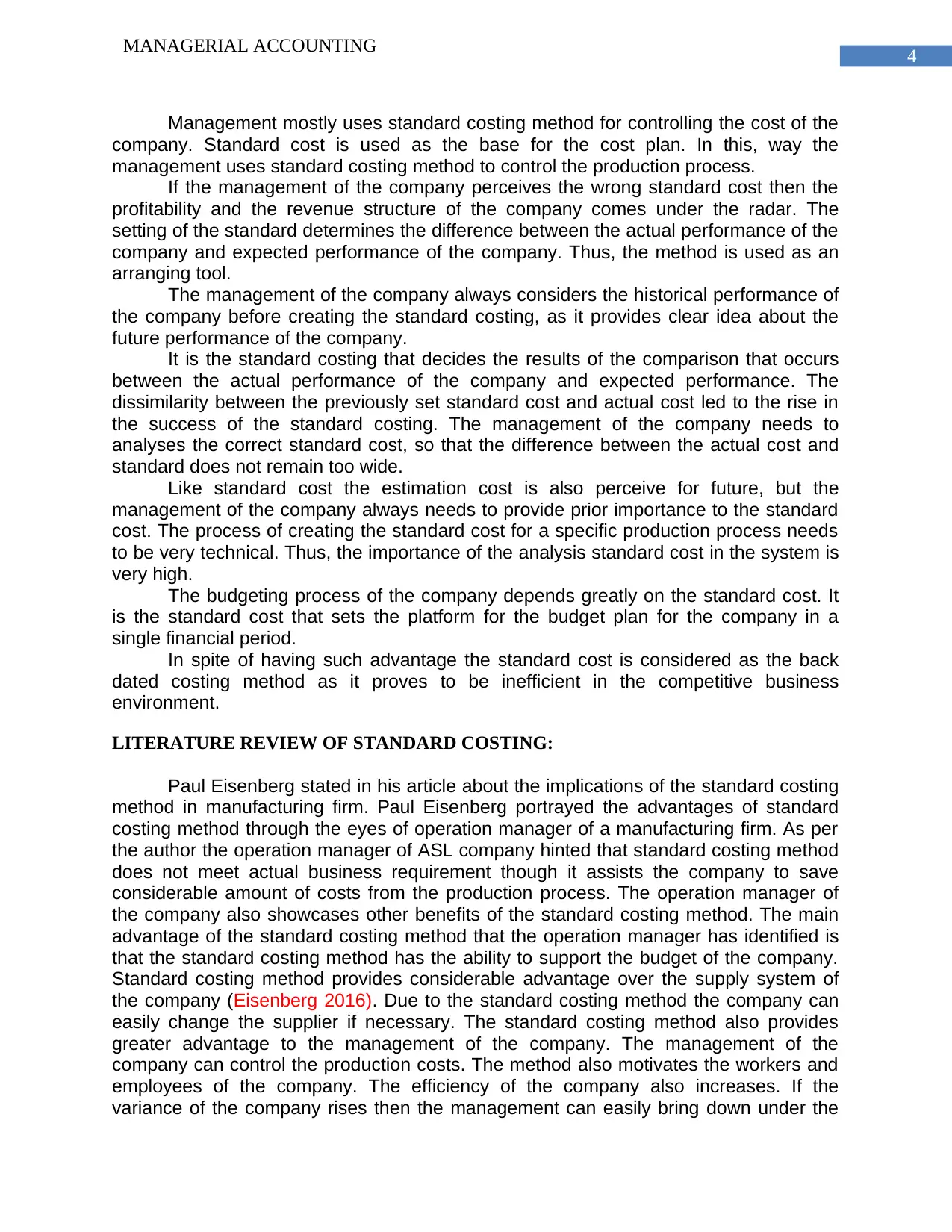
4
MANAGERIAL ACCOUNTING
Management mostly uses standard costing method for controlling the cost of the
company. Standard cost is used as the base for the cost plan. In this, way the
management uses standard costing method to control the production process.
If the management of the company perceives the wrong standard cost then the
profitability and the revenue structure of the company comes under the radar. The
setting of the standard determines the difference between the actual performance of the
company and expected performance of the company. Thus, the method is used as an
arranging tool.
The management of the company always considers the historical performance of
the company before creating the standard costing, as it provides clear idea about the
future performance of the company.
It is the standard costing that decides the results of the comparison that occurs
between the actual performance of the company and expected performance. The
dissimilarity between the previously set standard cost and actual cost led to the rise in
the success of the standard costing. The management of the company needs to
analyses the correct standard cost, so that the difference between the actual cost and
standard does not remain too wide.
Like standard cost the estimation cost is also perceive for future, but the
management of the company always needs to provide prior importance to the standard
cost. The process of creating the standard cost for a specific production process needs
to be very technical. Thus, the importance of the analysis standard cost in the system is
very high.
The budgeting process of the company depends greatly on the standard cost. It
is the standard cost that sets the platform for the budget plan for the company in a
single financial period.
In spite of having such advantage the standard cost is considered as the back
dated costing method as it proves to be inefficient in the competitive business
environment.
LITERATURE REVIEW OF STANDARD COSTING:
Paul Eisenberg stated in his article about the implications of the standard costing
method in manufacturing firm. Paul Eisenberg portrayed the advantages of standard
costing method through the eyes of operation manager of a manufacturing firm. As per
the author the operation manager of ASL company hinted that standard costing method
does not meet actual business requirement though it assists the company to save
considerable amount of costs from the production process. The operation manager of
the company also showcases other benefits of the standard costing method. The main
advantage of the standard costing method that the operation manager has identified is
that the standard costing method has the ability to support the budget of the company.
Standard costing method provides considerable advantage over the supply system of
the company (Eisenberg 2016). Due to the standard costing method the company can
easily change the supplier if necessary. The standard costing method also provides
greater advantage to the management of the company. The management of the
company can control the production costs. The method also motivates the workers and
employees of the company. The efficiency of the company also increases. If the
variance of the company rises then the management can easily bring down under the
MANAGERIAL ACCOUNTING
Management mostly uses standard costing method for controlling the cost of the
company. Standard cost is used as the base for the cost plan. In this, way the
management uses standard costing method to control the production process.
If the management of the company perceives the wrong standard cost then the
profitability and the revenue structure of the company comes under the radar. The
setting of the standard determines the difference between the actual performance of the
company and expected performance of the company. Thus, the method is used as an
arranging tool.
The management of the company always considers the historical performance of
the company before creating the standard costing, as it provides clear idea about the
future performance of the company.
It is the standard costing that decides the results of the comparison that occurs
between the actual performance of the company and expected performance. The
dissimilarity between the previously set standard cost and actual cost led to the rise in
the success of the standard costing. The management of the company needs to
analyses the correct standard cost, so that the difference between the actual cost and
standard does not remain too wide.
Like standard cost the estimation cost is also perceive for future, but the
management of the company always needs to provide prior importance to the standard
cost. The process of creating the standard cost for a specific production process needs
to be very technical. Thus, the importance of the analysis standard cost in the system is
very high.
The budgeting process of the company depends greatly on the standard cost. It
is the standard cost that sets the platform for the budget plan for the company in a
single financial period.
In spite of having such advantage the standard cost is considered as the back
dated costing method as it proves to be inefficient in the competitive business
environment.
LITERATURE REVIEW OF STANDARD COSTING:
Paul Eisenberg stated in his article about the implications of the standard costing
method in manufacturing firm. Paul Eisenberg portrayed the advantages of standard
costing method through the eyes of operation manager of a manufacturing firm. As per
the author the operation manager of ASL company hinted that standard costing method
does not meet actual business requirement though it assists the company to save
considerable amount of costs from the production process. The operation manager of
the company also showcases other benefits of the standard costing method. The main
advantage of the standard costing method that the operation manager has identified is
that the standard costing method has the ability to support the budget of the company.
Standard costing method provides considerable advantage over the supply system of
the company (Eisenberg 2016). Due to the standard costing method the company can
easily change the supplier if necessary. The standard costing method also provides
greater advantage to the management of the company. The management of the
company can control the production costs. The method also motivates the workers and
employees of the company. The efficiency of the company also increases. If the
variance of the company rises then the management can easily bring down under the

5
MANAGERIAL ACCOUNTING
acceptable limits. Another main advantage that the standard costing method brings in
the company is that the reporting process inside the company increases by
considerable means. The decision-making process of the company also rises by
considerable means (Eisenberg 2016).
In spite of having considerable amount of advantage the author also discusses
about the disadvantage of standard costing method. As per the author the standard
costing method is incompetent in this modern business world. To showcase this, the
author has provided numerous amounts of disadvantage in its article. The main
disadvantage of the standard costing methods that the author has highlighted in its
article are as follows:
- Standard costing method sometimes in able to handle the non-controllable costs,
which results in demotivating the staff and hence the performance of the company
decreases by considerable means.
- Since the standard cost is controllable, so nit can be manipulated easily.
- Standard costing method always consider the idle time and omits the waste, which
affects the results.
After analyzing the advantage and disadvantage of the standard costing method
the operation manager of ASL company came into conclusion that the standard costing
method can be implemented in the company if the company improves the financial and
operational improvement (Eisenberg 2016). The efficiency of the company cannot be
measured by the standard costing method. The operation manager of the company
suggested that other costing method considers the efficiency as major variance but the
standard costing method does not consider the efficiency as the variance. Thus, the
operation manager suggested that the standard costing method needs to changed and
a new modern costing method like TQM should be implemented in the system.
TARGET COSTING:
The management of the company often uses the target costing as the tool to
reduce the cost and increase the sales revenue of the company. It is the tool that the
management uses for formulating a plan that sets the base for the price points, margin
and the product cost of the new product. It is also uses as the tool to monitor the whole
life cycle of the products. It means that target costing assists the manager to check the
whole process starting from designing phase to ending phase of the production process.
Thus, it is considered as one of the best costing method that assists the company to
compete in this competitive business world. This is the reason it is considered as the
tool that many manufacturing organizations around the world uses it to increase their
profitability margin. The steps to implement the target costing are as follows:
The company needs to conduct thorough research.
The management of the company also needs to calculate the maximum
cost.
To monitor the ongoing activities of the company.
MANAGERIAL ACCOUNTING
acceptable limits. Another main advantage that the standard costing method brings in
the company is that the reporting process inside the company increases by
considerable means. The decision-making process of the company also rises by
considerable means (Eisenberg 2016).
In spite of having considerable amount of advantage the author also discusses
about the disadvantage of standard costing method. As per the author the standard
costing method is incompetent in this modern business world. To showcase this, the
author has provided numerous amounts of disadvantage in its article. The main
disadvantage of the standard costing methods that the author has highlighted in its
article are as follows:
- Standard costing method sometimes in able to handle the non-controllable costs,
which results in demotivating the staff and hence the performance of the company
decreases by considerable means.
- Since the standard cost is controllable, so nit can be manipulated easily.
- Standard costing method always consider the idle time and omits the waste, which
affects the results.
After analyzing the advantage and disadvantage of the standard costing method
the operation manager of ASL company came into conclusion that the standard costing
method can be implemented in the company if the company improves the financial and
operational improvement (Eisenberg 2016). The efficiency of the company cannot be
measured by the standard costing method. The operation manager of the company
suggested that other costing method considers the efficiency as major variance but the
standard costing method does not consider the efficiency as the variance. Thus, the
operation manager suggested that the standard costing method needs to changed and
a new modern costing method like TQM should be implemented in the system.
TARGET COSTING:
The management of the company often uses the target costing as the tool to
reduce the cost and increase the sales revenue of the company. It is the tool that the
management uses for formulating a plan that sets the base for the price points, margin
and the product cost of the new product. It is also uses as the tool to monitor the whole
life cycle of the products. It means that target costing assists the manager to check the
whole process starting from designing phase to ending phase of the production process.
Thus, it is considered as one of the best costing method that assists the company to
compete in this competitive business world. This is the reason it is considered as the
tool that many manufacturing organizations around the world uses it to increase their
profitability margin. The steps to implement the target costing are as follows:
The company needs to conduct thorough research.
The management of the company also needs to calculate the maximum
cost.
To monitor the ongoing activities of the company.
⊘ This is a preview!⊘
Do you want full access?
Subscribe today to unlock all pages.

Trusted by 1+ million students worldwide

6
MANAGERIAL ACCOUNTING
Target costing assists the management of the company to create a proactive
cost planning. The target costing is an integral part of cost reduction process and cost
management of the company.
The targeting costing usually sets by the manager before the start of the
designing stage or during the development stage of the product.
The market price of the product of the company is uncontrollable, as it keeps on
changing. Thus, the target costing method considers the market price while formulating
the market price of the company.
The cost management assists the company to reduce the cost of the company.
Target costing method is considered to be an integral part of the cost reduction strategy
of the company (Ferrara et al 2014). The reduction in cost assists the company to gain
more revenue from the market.
The selling price of any product mostly depends on target costing methods. The
formulation of the selling price also depends on the satisfaction and expectations of the
customers. Thus, target costing method clearly depends on the target cost.
The current cost of the company arte taken into consideration while formulating
the cost reduction process. This is also the ultimate goal for targeting costing.
COMPARISON BETWEEN STANDARD COSTING AND TARGET COSTING:
The management of the company considers both the standard costing method
and target costing method while reduction of the total cost of the company. In spite of
having striking similarity and almost same kind of objective the standard costing differs
from target costing. The difference between the target costing and standard costing are
as follows:
Target costing is a modern method that considers all the modern attributes while
standard costing is an old method that helps the company to reduce the cost but it is not
efficient enough in the modern business world.
Target cost is considered as the measurement that identifies the lowest cost
required to create a product, so that the company can earn revenue. Standard costing,
on the other hand, are being fixed by the management before the production cycle
starts.
Target costing method assists the company to search the lowest cost after
considering the present market situation. Standard costing method does not consider
the present market situation but instead it just predicts the future using the internal data.
Target costing method used solely to reduce the cost of the company whereas
the standard cost is used to control the cost of the company. (Sullivan 2015). Target
costing also assists the management of the company to create a design for the various
stages of the product life cycle.
Business organizations around the world usually develop the standard costing
during the development stage and develop target costing during the production stage,
so that the reduction of the cost is possible.
MANAGERIAL ACCOUNTING
Target costing assists the management of the company to create a proactive
cost planning. The target costing is an integral part of cost reduction process and cost
management of the company.
The targeting costing usually sets by the manager before the start of the
designing stage or during the development stage of the product.
The market price of the product of the company is uncontrollable, as it keeps on
changing. Thus, the target costing method considers the market price while formulating
the market price of the company.
The cost management assists the company to reduce the cost of the company.
Target costing method is considered to be an integral part of the cost reduction strategy
of the company (Ferrara et al 2014). The reduction in cost assists the company to gain
more revenue from the market.
The selling price of any product mostly depends on target costing methods. The
formulation of the selling price also depends on the satisfaction and expectations of the
customers. Thus, target costing method clearly depends on the target cost.
The current cost of the company arte taken into consideration while formulating
the cost reduction process. This is also the ultimate goal for targeting costing.
COMPARISON BETWEEN STANDARD COSTING AND TARGET COSTING:
The management of the company considers both the standard costing method
and target costing method while reduction of the total cost of the company. In spite of
having striking similarity and almost same kind of objective the standard costing differs
from target costing. The difference between the target costing and standard costing are
as follows:
Target costing is a modern method that considers all the modern attributes while
standard costing is an old method that helps the company to reduce the cost but it is not
efficient enough in the modern business world.
Target cost is considered as the measurement that identifies the lowest cost
required to create a product, so that the company can earn revenue. Standard costing,
on the other hand, are being fixed by the management before the production cycle
starts.
Target costing method assists the company to search the lowest cost after
considering the present market situation. Standard costing method does not consider
the present market situation but instead it just predicts the future using the internal data.
Target costing method used solely to reduce the cost of the company whereas
the standard cost is used to control the cost of the company. (Sullivan 2015). Target
costing also assists the management of the company to create a design for the various
stages of the product life cycle.
Business organizations around the world usually develop the standard costing
during the development stage and develop target costing during the production stage,
so that the reduction of the cost is possible.
Paraphrase This Document
Need a fresh take? Get an instant paraphrase of this document with our AI Paraphraser
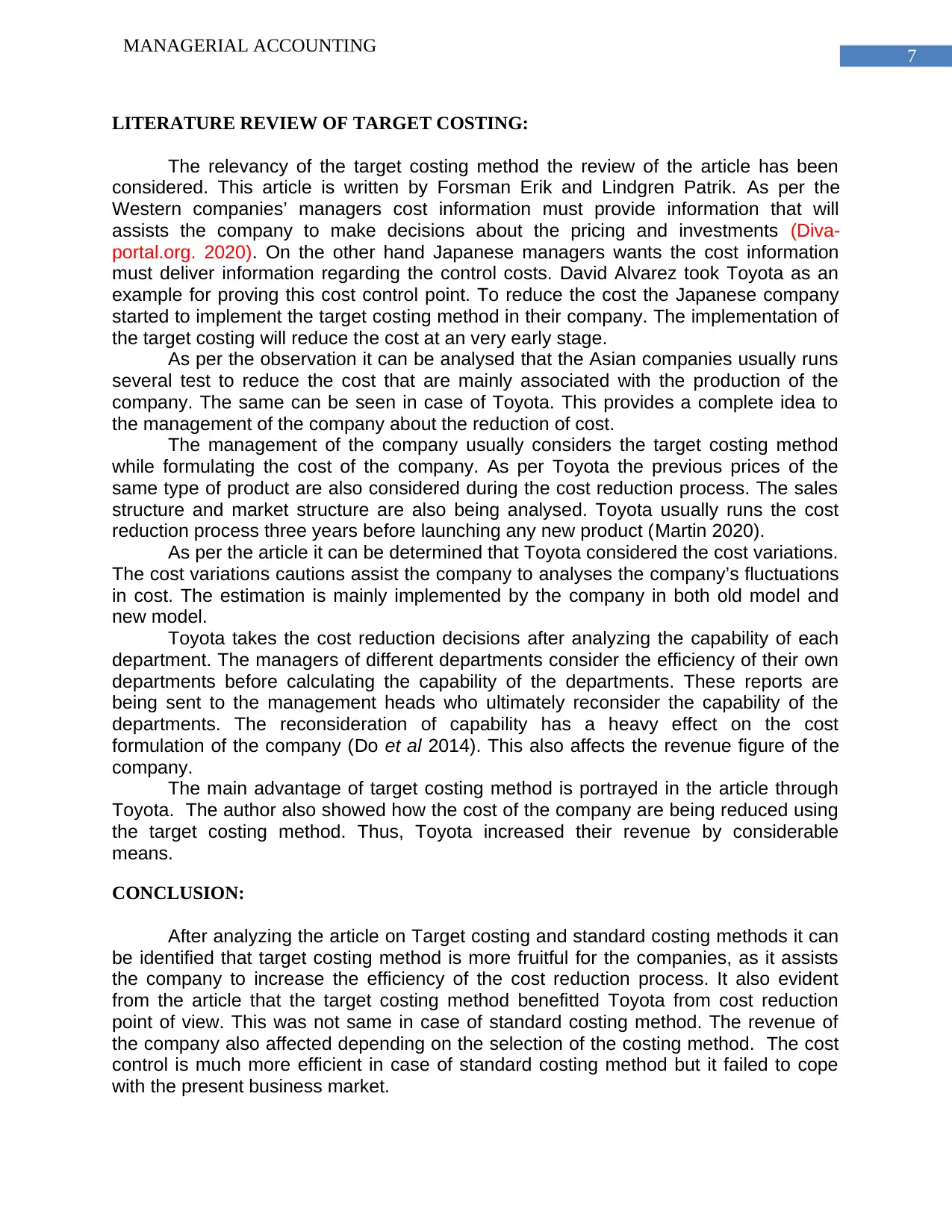
7
MANAGERIAL ACCOUNTING
LITERATURE REVIEW OF TARGET COSTING:
The relevancy of the target costing method the review of the article has been
considered. This article is written by Forsman Erik and Lindgren Patrik. As per the
Western companies’ managers cost information must provide information that will
assists the company to make decisions about the pricing and investments (Diva-
portal.org. 2020). On the other hand Japanese managers wants the cost information
must deliver information regarding the control costs. David Alvarez took Toyota as an
example for proving this cost control point. To reduce the cost the Japanese company
started to implement the target costing method in their company. The implementation of
the target costing will reduce the cost at an very early stage.
As per the observation it can be analysed that the Asian companies usually runs
several test to reduce the cost that are mainly associated with the production of the
company. The same can be seen in case of Toyota. This provides a complete idea to
the management of the company about the reduction of cost.
The management of the company usually considers the target costing method
while formulating the cost of the company. As per Toyota the previous prices of the
same type of product are also considered during the cost reduction process. The sales
structure and market structure are also being analysed. Toyota usually runs the cost
reduction process three years before launching any new product (Martin 2020).
As per the article it can be determined that Toyota considered the cost variations.
The cost variations cautions assist the company to analyses the company’s fluctuations
in cost. The estimation is mainly implemented by the company in both old model and
new model.
Toyota takes the cost reduction decisions after analyzing the capability of each
department. The managers of different departments consider the efficiency of their own
departments before calculating the capability of the departments. These reports are
being sent to the management heads who ultimately reconsider the capability of the
departments. The reconsideration of capability has a heavy effect on the cost
formulation of the company (Do et al 2014). This also affects the revenue figure of the
company.
The main advantage of target costing method is portrayed in the article through
Toyota. The author also showed how the cost of the company are being reduced using
the target costing method. Thus, Toyota increased their revenue by considerable
means.
CONCLUSION:
After analyzing the article on Target costing and standard costing methods it can
be identified that target costing method is more fruitful for the companies, as it assists
the company to increase the efficiency of the cost reduction process. It also evident
from the article that the target costing method benefitted Toyota from cost reduction
point of view. This was not same in case of standard costing method. The revenue of
the company also affected depending on the selection of the costing method. The cost
control is much more efficient in case of standard costing method but it failed to cope
with the present business market.
MANAGERIAL ACCOUNTING
LITERATURE REVIEW OF TARGET COSTING:
The relevancy of the target costing method the review of the article has been
considered. This article is written by Forsman Erik and Lindgren Patrik. As per the
Western companies’ managers cost information must provide information that will
assists the company to make decisions about the pricing and investments (Diva-
portal.org. 2020). On the other hand Japanese managers wants the cost information
must deliver information regarding the control costs. David Alvarez took Toyota as an
example for proving this cost control point. To reduce the cost the Japanese company
started to implement the target costing method in their company. The implementation of
the target costing will reduce the cost at an very early stage.
As per the observation it can be analysed that the Asian companies usually runs
several test to reduce the cost that are mainly associated with the production of the
company. The same can be seen in case of Toyota. This provides a complete idea to
the management of the company about the reduction of cost.
The management of the company usually considers the target costing method
while formulating the cost of the company. As per Toyota the previous prices of the
same type of product are also considered during the cost reduction process. The sales
structure and market structure are also being analysed. Toyota usually runs the cost
reduction process three years before launching any new product (Martin 2020).
As per the article it can be determined that Toyota considered the cost variations.
The cost variations cautions assist the company to analyses the company’s fluctuations
in cost. The estimation is mainly implemented by the company in both old model and
new model.
Toyota takes the cost reduction decisions after analyzing the capability of each
department. The managers of different departments consider the efficiency of their own
departments before calculating the capability of the departments. These reports are
being sent to the management heads who ultimately reconsider the capability of the
departments. The reconsideration of capability has a heavy effect on the cost
formulation of the company (Do et al 2014). This also affects the revenue figure of the
company.
The main advantage of target costing method is portrayed in the article through
Toyota. The author also showed how the cost of the company are being reduced using
the target costing method. Thus, Toyota increased their revenue by considerable
means.
CONCLUSION:
After analyzing the article on Target costing and standard costing methods it can
be identified that target costing method is more fruitful for the companies, as it assists
the company to increase the efficiency of the cost reduction process. It also evident
from the article that the target costing method benefitted Toyota from cost reduction
point of view. This was not same in case of standard costing method. The revenue of
the company also affected depending on the selection of the costing method. The cost
control is much more efficient in case of standard costing method but it failed to cope
with the present business market.
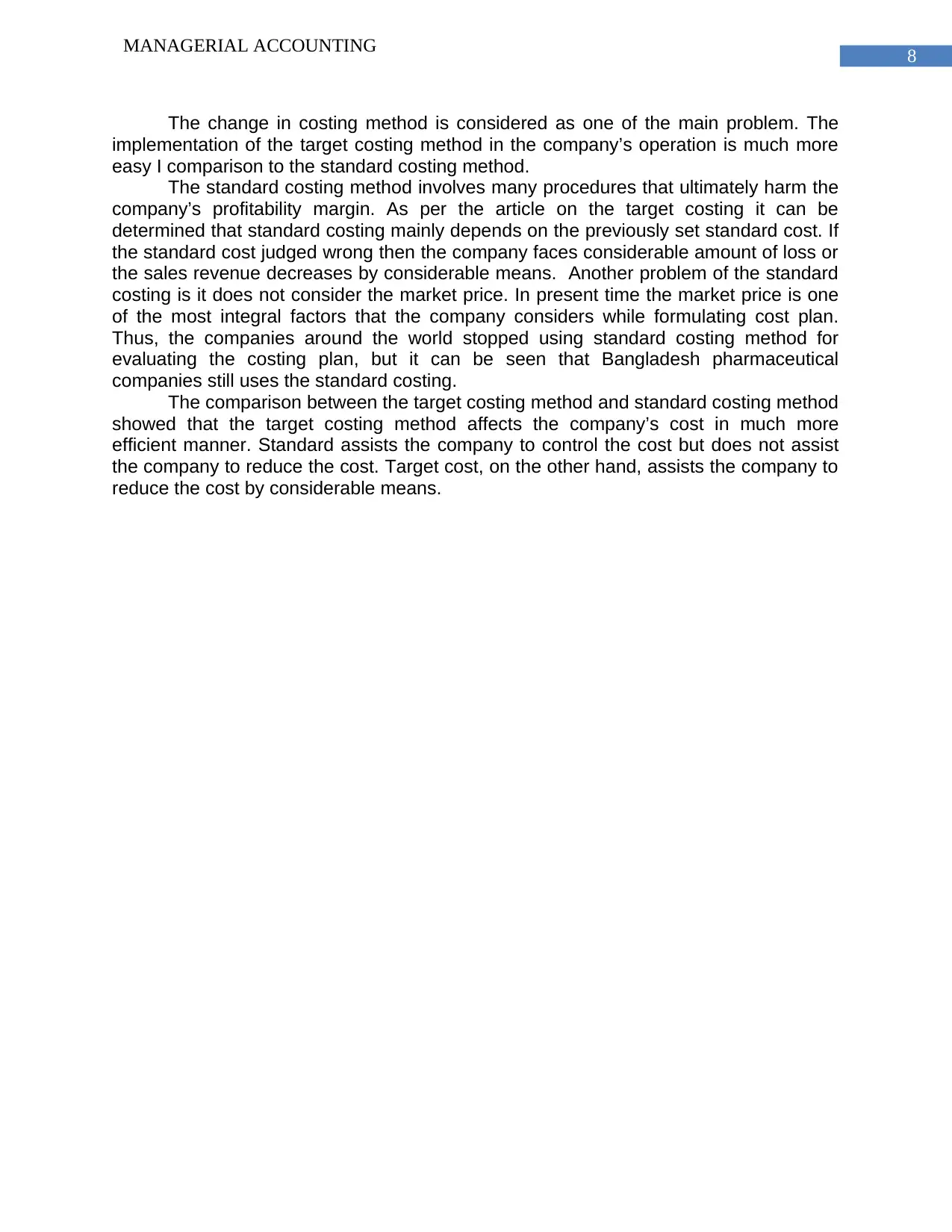
8
MANAGERIAL ACCOUNTING
The change in costing method is considered as one of the main problem. The
implementation of the target costing method in the company’s operation is much more
easy I comparison to the standard costing method.
The standard costing method involves many procedures that ultimately harm the
company’s profitability margin. As per the article on the target costing it can be
determined that standard costing mainly depends on the previously set standard cost. If
the standard cost judged wrong then the company faces considerable amount of loss or
the sales revenue decreases by considerable means. Another problem of the standard
costing is it does not consider the market price. In present time the market price is one
of the most integral factors that the company considers while formulating cost plan.
Thus, the companies around the world stopped using standard costing method for
evaluating the costing plan, but it can be seen that Bangladesh pharmaceutical
companies still uses the standard costing.
The comparison between the target costing method and standard costing method
showed that the target costing method affects the company’s cost in much more
efficient manner. Standard assists the company to control the cost but does not assist
the company to reduce the cost. Target cost, on the other hand, assists the company to
reduce the cost by considerable means.
MANAGERIAL ACCOUNTING
The change in costing method is considered as one of the main problem. The
implementation of the target costing method in the company’s operation is much more
easy I comparison to the standard costing method.
The standard costing method involves many procedures that ultimately harm the
company’s profitability margin. As per the article on the target costing it can be
determined that standard costing mainly depends on the previously set standard cost. If
the standard cost judged wrong then the company faces considerable amount of loss or
the sales revenue decreases by considerable means. Another problem of the standard
costing is it does not consider the market price. In present time the market price is one
of the most integral factors that the company considers while formulating cost plan.
Thus, the companies around the world stopped using standard costing method for
evaluating the costing plan, but it can be seen that Bangladesh pharmaceutical
companies still uses the standard costing.
The comparison between the target costing method and standard costing method
showed that the target costing method affects the company’s cost in much more
efficient manner. Standard assists the company to control the cost but does not assist
the company to reduce the cost. Target cost, on the other hand, assists the company to
reduce the cost by considerable means.
⊘ This is a preview!⊘
Do you want full access?
Subscribe today to unlock all pages.

Trusted by 1+ million students worldwide
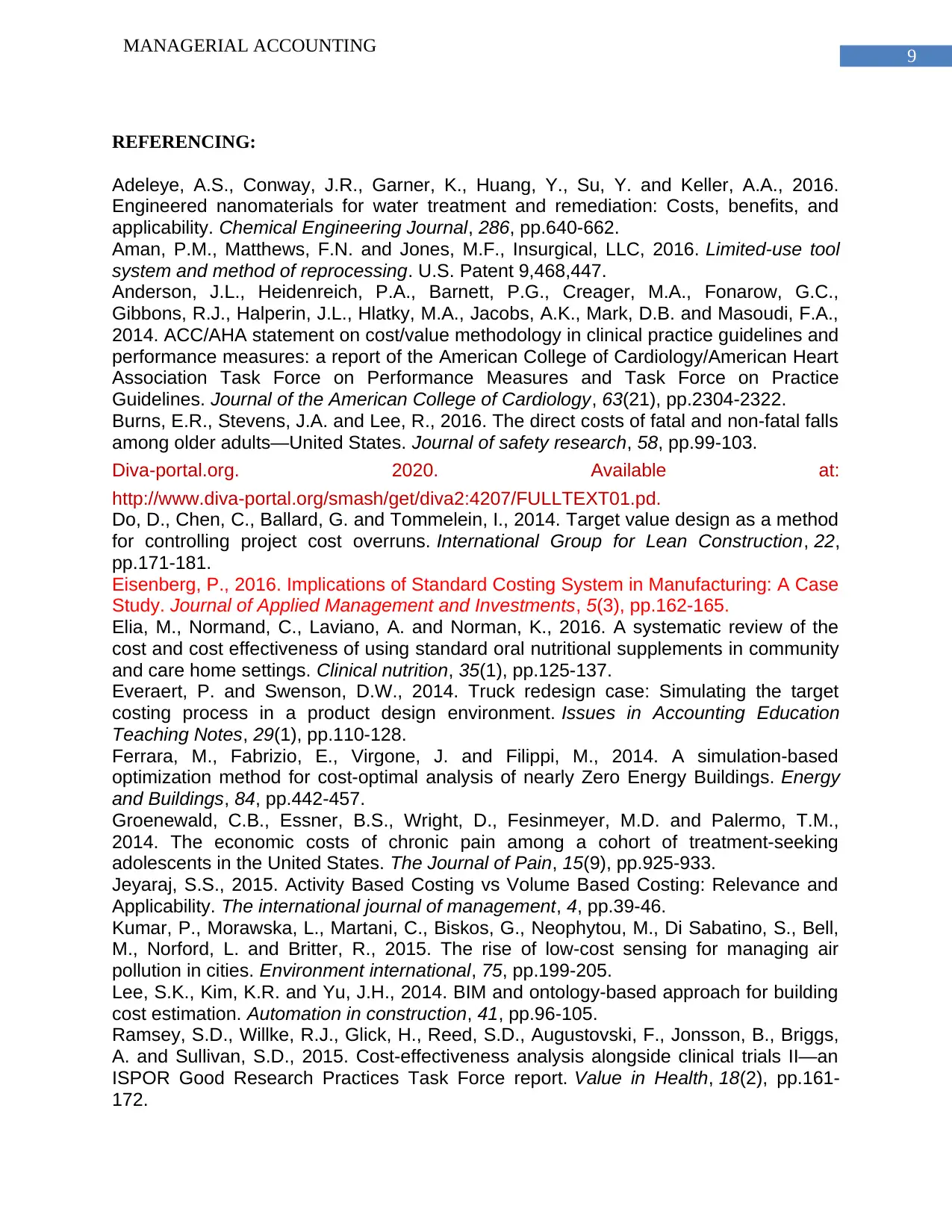
9
MANAGERIAL ACCOUNTING
REFERENCING:
Adeleye, A.S., Conway, J.R., Garner, K., Huang, Y., Su, Y. and Keller, A.A., 2016.
Engineered nanomaterials for water treatment and remediation: Costs, benefits, and
applicability. Chemical Engineering Journal, 286, pp.640-662.
Aman, P.M., Matthews, F.N. and Jones, M.F., Insurgical, LLC, 2016. Limited-use tool
system and method of reprocessing. U.S. Patent 9,468,447.
Anderson, J.L., Heidenreich, P.A., Barnett, P.G., Creager, M.A., Fonarow, G.C.,
Gibbons, R.J., Halperin, J.L., Hlatky, M.A., Jacobs, A.K., Mark, D.B. and Masoudi, F.A.,
2014. ACC/AHA statement on cost/value methodology in clinical practice guidelines and
performance measures: a report of the American College of Cardiology/American Heart
Association Task Force on Performance Measures and Task Force on Practice
Guidelines. Journal of the American College of Cardiology, 63(21), pp.2304-2322.
Burns, E.R., Stevens, J.A. and Lee, R., 2016. The direct costs of fatal and non-fatal falls
among older adults—United States. Journal of safety research, 58, pp.99-103.
Diva-portal.org. 2020. Available at:
http://www.diva-portal.org/smash/get/diva2:4207/FULLTEXT01.pd.
Do, D., Chen, C., Ballard, G. and Tommelein, I., 2014. Target value design as a method
for controlling project cost overruns. International Group for Lean Construction, 22,
pp.171-181.
Eisenberg, P., 2016. Implications of Standard Costing System in Manufacturing: A Case
Study. Journal of Applied Management and Investments, 5(3), pp.162-165.
Elia, M., Normand, C., Laviano, A. and Norman, K., 2016. A systematic review of the
cost and cost effectiveness of using standard oral nutritional supplements in community
and care home settings. Clinical nutrition, 35(1), pp.125-137.
Everaert, P. and Swenson, D.W., 2014. Truck redesign case: Simulating the target
costing process in a product design environment. Issues in Accounting Education
Teaching Notes, 29(1), pp.110-128.
Ferrara, M., Fabrizio, E., Virgone, J. and Filippi, M., 2014. A simulation-based
optimization method for cost-optimal analysis of nearly Zero Energy Buildings. Energy
and Buildings, 84, pp.442-457.
Groenewald, C.B., Essner, B.S., Wright, D., Fesinmeyer, M.D. and Palermo, T.M.,
2014. The economic costs of chronic pain among a cohort of treatment-seeking
adolescents in the United States. The Journal of Pain, 15(9), pp.925-933.
Jeyaraj, S.S., 2015. Activity Based Costing vs Volume Based Costing: Relevance and
Applicability. The international journal of management, 4, pp.39-46.
Kumar, P., Morawska, L., Martani, C., Biskos, G., Neophytou, M., Di Sabatino, S., Bell,
M., Norford, L. and Britter, R., 2015. The rise of low-cost sensing for managing air
pollution in cities. Environment international, 75, pp.199-205.
Lee, S.K., Kim, K.R. and Yu, J.H., 2014. BIM and ontology-based approach for building
cost estimation. Automation in construction, 41, pp.96-105.
Ramsey, S.D., Willke, R.J., Glick, H., Reed, S.D., Augustovski, F., Jonsson, B., Briggs,
A. and Sullivan, S.D., 2015. Cost-effectiveness analysis alongside clinical trials II—an
ISPOR Good Research Practices Task Force report. Value in Health, 18(2), pp.161-
172.
MANAGERIAL ACCOUNTING
REFERENCING:
Adeleye, A.S., Conway, J.R., Garner, K., Huang, Y., Su, Y. and Keller, A.A., 2016.
Engineered nanomaterials for water treatment and remediation: Costs, benefits, and
applicability. Chemical Engineering Journal, 286, pp.640-662.
Aman, P.M., Matthews, F.N. and Jones, M.F., Insurgical, LLC, 2016. Limited-use tool
system and method of reprocessing. U.S. Patent 9,468,447.
Anderson, J.L., Heidenreich, P.A., Barnett, P.G., Creager, M.A., Fonarow, G.C.,
Gibbons, R.J., Halperin, J.L., Hlatky, M.A., Jacobs, A.K., Mark, D.B. and Masoudi, F.A.,
2014. ACC/AHA statement on cost/value methodology in clinical practice guidelines and
performance measures: a report of the American College of Cardiology/American Heart
Association Task Force on Performance Measures and Task Force on Practice
Guidelines. Journal of the American College of Cardiology, 63(21), pp.2304-2322.
Burns, E.R., Stevens, J.A. and Lee, R., 2016. The direct costs of fatal and non-fatal falls
among older adults—United States. Journal of safety research, 58, pp.99-103.
Diva-portal.org. 2020. Available at:
http://www.diva-portal.org/smash/get/diva2:4207/FULLTEXT01.pd.
Do, D., Chen, C., Ballard, G. and Tommelein, I., 2014. Target value design as a method
for controlling project cost overruns. International Group for Lean Construction, 22,
pp.171-181.
Eisenberg, P., 2016. Implications of Standard Costing System in Manufacturing: A Case
Study. Journal of Applied Management and Investments, 5(3), pp.162-165.
Elia, M., Normand, C., Laviano, A. and Norman, K., 2016. A systematic review of the
cost and cost effectiveness of using standard oral nutritional supplements in community
and care home settings. Clinical nutrition, 35(1), pp.125-137.
Everaert, P. and Swenson, D.W., 2014. Truck redesign case: Simulating the target
costing process in a product design environment. Issues in Accounting Education
Teaching Notes, 29(1), pp.110-128.
Ferrara, M., Fabrizio, E., Virgone, J. and Filippi, M., 2014. A simulation-based
optimization method for cost-optimal analysis of nearly Zero Energy Buildings. Energy
and Buildings, 84, pp.442-457.
Groenewald, C.B., Essner, B.S., Wright, D., Fesinmeyer, M.D. and Palermo, T.M.,
2014. The economic costs of chronic pain among a cohort of treatment-seeking
adolescents in the United States. The Journal of Pain, 15(9), pp.925-933.
Jeyaraj, S.S., 2015. Activity Based Costing vs Volume Based Costing: Relevance and
Applicability. The international journal of management, 4, pp.39-46.
Kumar, P., Morawska, L., Martani, C., Biskos, G., Neophytou, M., Di Sabatino, S., Bell,
M., Norford, L. and Britter, R., 2015. The rise of low-cost sensing for managing air
pollution in cities. Environment international, 75, pp.199-205.
Lee, S.K., Kim, K.R. and Yu, J.H., 2014. BIM and ontology-based approach for building
cost estimation. Automation in construction, 41, pp.96-105.
Ramsey, S.D., Willke, R.J., Glick, H., Reed, S.D., Augustovski, F., Jonsson, B., Briggs,
A. and Sullivan, S.D., 2015. Cost-effectiveness analysis alongside clinical trials II—an
ISPOR Good Research Practices Task Force report. Value in Health, 18(2), pp.161-
172.
Paraphrase This Document
Need a fresh take? Get an instant paraphrase of this document with our AI Paraphraser
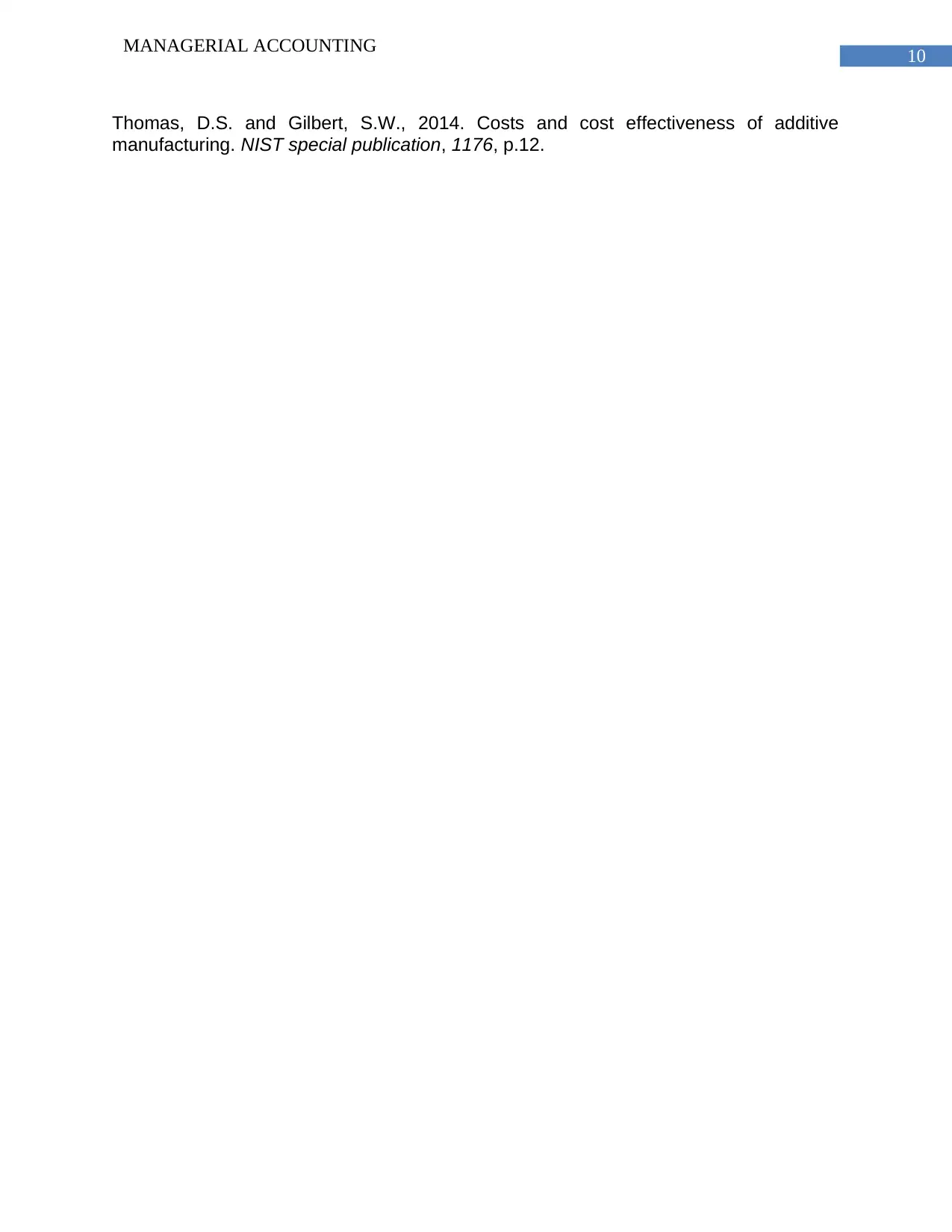
10
MANAGERIAL ACCOUNTING
Thomas, D.S. and Gilbert, S.W., 2014. Costs and cost effectiveness of additive
manufacturing. NIST special publication, 1176, p.12.
MANAGERIAL ACCOUNTING
Thomas, D.S. and Gilbert, S.W., 2014. Costs and cost effectiveness of additive
manufacturing. NIST special publication, 1176, p.12.
1 out of 11
Related Documents
Your All-in-One AI-Powered Toolkit for Academic Success.
+13062052269
info@desklib.com
Available 24*7 on WhatsApp / Email
![[object Object]](/_next/static/media/star-bottom.7253800d.svg)
Unlock your academic potential
Copyright © 2020–2025 A2Z Services. All Rights Reserved. Developed and managed by ZUCOL.





